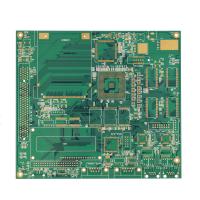Unlike a Double-Sided PCB which only has two conductive layers of material, all multilayer PCBs must have at least three layers of conductive material which are buried in the center of the material.
How Are Multilayer PCBs Made?
Alternating layers of prepeg and core materials are laminated together under high temperature and pressure to produce Multilayer PCBs. This process ensures that air isn't trapped between layers, conductors are completely encapsulated by resin, and the adhesive that holds the layers together are properly melted and cured. The range of material combinations is extensive from basic epoxy glass to exotic ceramic or Teflon materials.
Benefits of Multilayer PCBs (compared to single or double-sided PCBs)
- Higher assembly density
- Smaller size (considerable savings on space)
- Increased flexibility
- Easier incorporation controlled impedance features.
- EMI shielding through careful placement of power and ground layers.
- Reduces the need for interconnection wiring harnesses (reduces overall weight)
IBE is an Experienced Multilayer PCB Manufacturer
IBE has been producing Multilayer PCBs for over 20 years. Over the years, we have seen all types of multilayer constructions from various industries, answered all types of multilayer questions, and solved all types of problems with multilayer PCBs.







